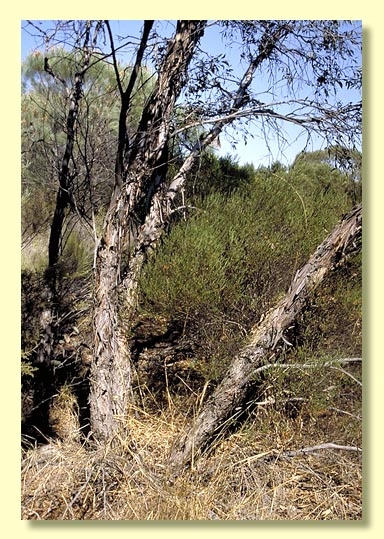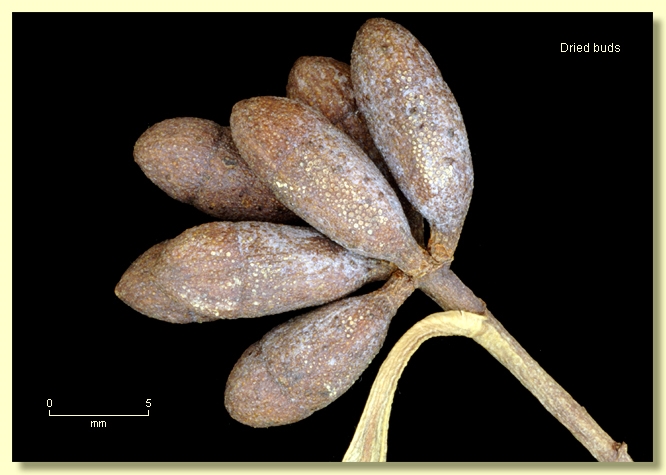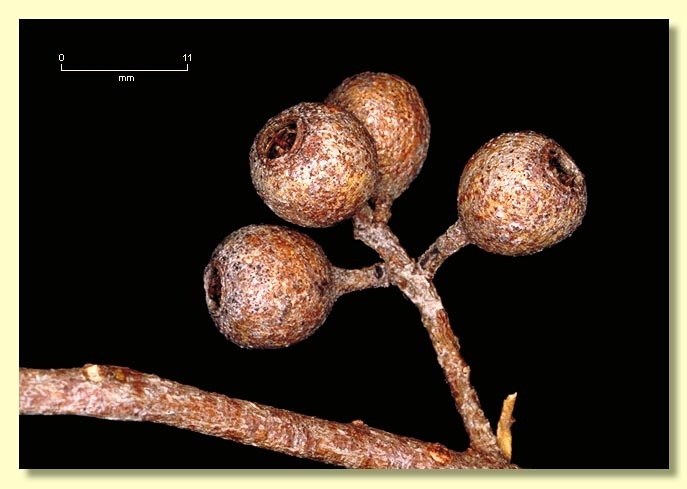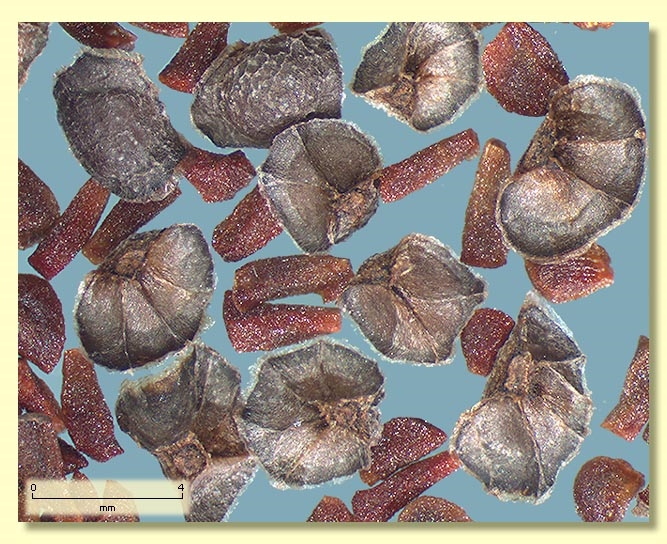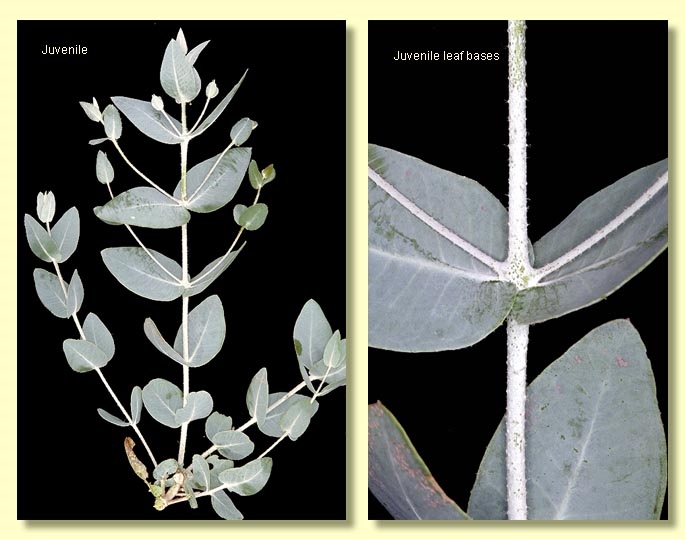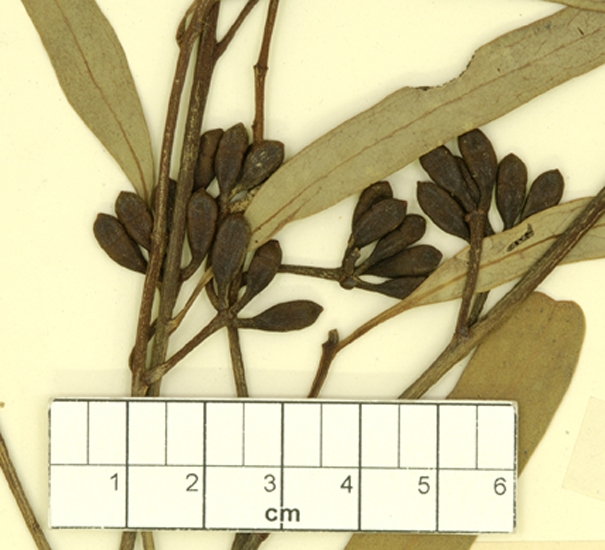Euclid - Online edition
Eucalyptus jucunda
Classification
Eucalyptus | Eudesmia | Limbatae | Edentatae | Jucundae
Nomenclature
Eucalyptus jucunda C.A.Gardner, J. & Proc. Roy. Soc. Western Australia 47: 60 (1964).
T: Western Australia: near the Greenough River, 6 Jan. 1959, C.A.Gardner 12066; holo: PERTH; CANB.
T: Western Australia: near the Greenough River, 6 Jan. 1959, C.A.Gardner 12066; holo: PERTH; CANB.
Description
Mallee or small tree to 7 m tall. Forming a lignotuber.
Bark smooth, grey or grey-brown to creamy-brown, occasionally with grey, crumbly, fibrous, flaky, ribbony bark persisting on the lower trunk.
Branchlets not glaucous; oil glands present in the pith.
Juvenile stems rounded to square in cross-section, glaucous with stellate hairs; juvenile leaves opposite and sessile, ovate to cordate, glaucous, 2.5–5.7 cm long, 1.7–3.5 cm wide, apex acute to rarely rounded, base amplexicaul, usually with hairs on the margins and midribs, sometimes with irregular or crenate margins due to hairs.
Adult leaves alternate, petioles (0.9)1–2.2 cm long; blade lanceolate to slightly falcate, (5)6–12(16) cm long, (0.6)1–2(2.5) cm wide, base tapering to petiole, concolorous, dull, grey-green to green, side-veins venation acute, tertiary venation moderate, intramarginal vein present, oil glands mostly island, sometimes sparse or absent.
Inflorescence axillary single or axillary compound, peduncles 0.5–1.3 cm long, buds 7 or 9 per umbel, pedicellate (pedicels 0.1–0.4 cm long). Mature buds cylindrical to broadly fusiform (1.1–1.3 cm long, 0.5–0.6 cm wide), hypanthium not four-angled and usually not glaucous, outer perianth whorl minutely sepaline, inner whorl operculate, operculum conical to rounded, stamens irregularly flexed, not grouped in four clusters, anthers oblong, versatile, dorsifixed, dehiscing by longitudinal slits (non-confluent), style long, stigma tapered, locules usually 3 or 4, the ovules arranged in 4 distinct vertical rows on the placentae. Flowers white or cream.
Fruit pedicellate (pedicels 0.2–0.5 cm long), barrell-shape to truncate-globose, occasionally urceolate, 0.8–1.7 cm long, 0.8–1.5 cm wide, hypanthium not ridged, disc vertically descending, valves 3 or 4, enclosed or near the rim, orifice constricted.
Seeds dull brown to grey to black, obliquely pyramidal with a semi-translucent flange or wing around the edge, sides ridged, 2–3.5 mm long, surface smooth not pitted, hilum terminal.
Cultivated seedlings (measured at node 10): cotyledons reniform; stems round in cross-section, usually glaucous, occasionally non-glaucous, hairy; leaves petiolate, opposite for ca 7 nodes then becoming sub-opposite to alternate, or remaining opposite, ovate to broadly lanceolate, 6–8 cm long, 2.8–5 cm wide, dull, grey-green to glaucous, apex acute, base rounded to truncate, lamina glabrous except for a few hairs on the petiole, midrib and leaf margin.
Bark smooth, grey or grey-brown to creamy-brown, occasionally with grey, crumbly, fibrous, flaky, ribbony bark persisting on the lower trunk.
Branchlets not glaucous; oil glands present in the pith.
Juvenile stems rounded to square in cross-section, glaucous with stellate hairs; juvenile leaves opposite and sessile, ovate to cordate, glaucous, 2.5–5.7 cm long, 1.7–3.5 cm wide, apex acute to rarely rounded, base amplexicaul, usually with hairs on the margins and midribs, sometimes with irregular or crenate margins due to hairs.
Adult leaves alternate, petioles (0.9)1–2.2 cm long; blade lanceolate to slightly falcate, (5)6–12(16) cm long, (0.6)1–2(2.5) cm wide, base tapering to petiole, concolorous, dull, grey-green to green, side-veins venation acute, tertiary venation moderate, intramarginal vein present, oil glands mostly island, sometimes sparse or absent.
Inflorescence axillary single or axillary compound, peduncles 0.5–1.3 cm long, buds 7 or 9 per umbel, pedicellate (pedicels 0.1–0.4 cm long). Mature buds cylindrical to broadly fusiform (1.1–1.3 cm long, 0.5–0.6 cm wide), hypanthium not four-angled and usually not glaucous, outer perianth whorl minutely sepaline, inner whorl operculate, operculum conical to rounded, stamens irregularly flexed, not grouped in four clusters, anthers oblong, versatile, dorsifixed, dehiscing by longitudinal slits (non-confluent), style long, stigma tapered, locules usually 3 or 4, the ovules arranged in 4 distinct vertical rows on the placentae. Flowers white or cream.
Fruit pedicellate (pedicels 0.2–0.5 cm long), barrell-shape to truncate-globose, occasionally urceolate, 0.8–1.7 cm long, 0.8–1.5 cm wide, hypanthium not ridged, disc vertically descending, valves 3 or 4, enclosed or near the rim, orifice constricted.
Seeds dull brown to grey to black, obliquely pyramidal with a semi-translucent flange or wing around the edge, sides ridged, 2–3.5 mm long, surface smooth not pitted, hilum terminal.
Cultivated seedlings (measured at node 10): cotyledons reniform; stems round in cross-section, usually glaucous, occasionally non-glaucous, hairy; leaves petiolate, opposite for ca 7 nodes then becoming sub-opposite to alternate, or remaining opposite, ovate to broadly lanceolate, 6–8 cm long, 2.8–5 cm wide, dull, grey-green to glaucous, apex acute, base rounded to truncate, lamina glabrous except for a few hairs on the petiole, midrib and leaf margin.
Flowering Time
Flowering has been recorded in January.
Notes
Eucalyptus jucunda is a mallee occurring north of Perth from about Mingenew to the Kalbarri region. The bark is smooth or with rough, papery or flaky bark on the lower part of the stems. The adult leaves are dull or very slightly glossy, light green to grey-green.
It belongs to the taxonomically complex subgenus Eudesmia and is included in the section Limbatae, series Edentatae, subseries Jucundae, characterised by hairy or scabrid seedlings, buds with very small inconspicuous calyx lobes on the midline of the bud which do not persist onto the rim of the fruit, and winged or flanged seeds. E. jucunda is easily recognized in its natural area of occurrence particularly by the more or less globose fruit which has a very small orifice and the winged pyramidal seed.
Eucalyptus jucunda is most closely relared to E. gongylocarpa, a smooth-barked desert-dwelling tree from Western Australia and Central Australia. E. gongylocarpa differs further in having gluacous buds, fruit and juvenile leaves, and more flattened seed.
It belongs to the taxonomically complex subgenus Eudesmia and is included in the section Limbatae, series Edentatae, subseries Jucundae, characterised by hairy or scabrid seedlings, buds with very small inconspicuous calyx lobes on the midline of the bud which do not persist onto the rim of the fruit, and winged or flanged seeds. E. jucunda is easily recognized in its natural area of occurrence particularly by the more or less globose fruit which has a very small orifice and the winged pyramidal seed.
Eucalyptus jucunda is most closely relared to E. gongylocarpa, a smooth-barked desert-dwelling tree from Western Australia and Central Australia. E. gongylocarpa differs further in having gluacous buds, fruit and juvenile leaves, and more flattened seed.
Origin of Name
Eucalyptus jucunda: Latin jucundus, pleasant, allusion uncertain.
Copyright © CANBR 2020, all rights reserved.

Web edition hosted at https://apps.lucidcentral.org/euclid

